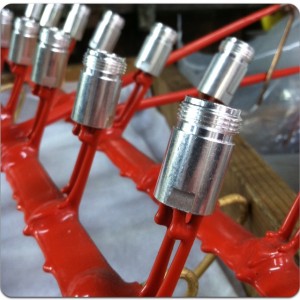Four Steps to a Successful Metal Finish – Surface Preparation
 Surface preparation is a crucial first stage in the metal plating process. An objects surface must be smooth and clean before electroplating can commence. The quality of a finish is contingent on its adherence to the substrate. Even the smallest remnants of surface contamination in the form of dust, grease, oil, oxide or dirt can be detrimental to a successful metal coating.
Surface preparation is a crucial first stage in the metal plating process. An objects surface must be smooth and clean before electroplating can commence. The quality of a finish is contingent on its adherence to the substrate. Even the smallest remnants of surface contamination in the form of dust, grease, oil, oxide or dirt can be detrimental to a successful metal coating.
In general, there are four primary steps to take during surface preparation. These include: (1) Disassembly, (2) Stripping, (3) Polishing and (4) Cleaning. In combination, if correctly implemented, these steps will ensure a clean and even surface ready for electroplating. Below we will take a look at each step in greater detail.
The Four Steps of Surface Metal Preparation:
Disassembly –Taking apart complex objects with multiple pieces or parts ensure for an even coverage. This step is the very first activity to take place during an objects journey to the electroplating bath. leaving an object together will leave areas un-plated. The edges of these areas will flake or peel.
Stripping–Professional platters use a selection of different mixes to attack and remove the excess plating or paint while leaving the base layer left untouched. Stripping will also remove several particles or other surface contamination which could cause blistering or flaking on the plate-layer.
Polishing – Typically, metal polishing involves the smoothing of an object using a buffing or polishing wheel in order to soften irregular surfaces or create a mirror-like finish. In addition, polishing is also used to prevent contamination of an object or eliminate oxidization contained on a metals outer coating.
Cleaning – Cleaning before metal plating is also very important. However, the requirements for the cleanliness of metal before electroplating are often much greater than other finishes. This is because a contaminant free surface is essential for the adherence of a plate-layer to the substrate. This step may include organic solvents, aqueous cleaners, semiaqueous cleaners, or rinsing.
Post-Surface Preparation:
Measuring the degree of cleanliness after the completion of these four steps is also important in order to make sure the surface is ready for electroplating.What substrate is being used? Asking this question makes the difference between an amateur and professional platter.
Electroplating is used on a numerous number of metals and each metal requires a different form of surface preparation. How much labor or material is required for the highest levels of cleanliness may cost additional sums of money. However, in most cases the best clean is worth the quality finish it helps to produce.
Additional information:
For additional information on the metal plating process see our blog or contact American Plating Company at (314) 776-0542.
